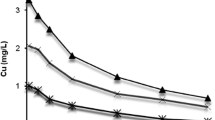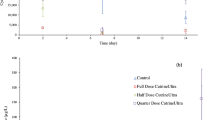Abstract
A pilot-scale study and field measurements at commercial ponds were conducted to investigate the environmental fate of copper (Cu) applied as an algaecide in commercial catfish ponds. In the pilot study, a total of 774 g Cu(II) was applied to an experimental catfish pond over a period of 16 summer weeks. More than 90% of Cu applied became associated with suspended sediment particles within a few minutes of addition, and then nearly all Cu applied was transferred to the sediment phase within about 2 days. At the end of the study, the peak Cu content in the sediment increased from an initial concentration of 25∼35 mg kg−1 to about 200 mg kg−1, and the applied Cu was able to reach a sediment depth of about 16 cm. Meanwhile, Cu concentration in the catfish body decreased from 12.7 ± 2.81 mg kg−1 to 6.15 ± 2.54 mg kg−1. Copper mass balance indicated that virtually all Cu applied was retained in the sediment. Only 0.01% of the total Cu applied was taken up by fish and 0.1% remained in pond water. Data from 3 commercial fishponds of different ages (1–25 years) and with different sediment types (acidic, neutral and calcareous) supported the pilot-scale observation. Both pilot-testing results and field measurements revealed that Cu is predominantly accumulated within the top sediment layer and barely reached the bottom soil regardless of the pond age and the type of the sediments. Field monitoring of groundwater quality suggested that the copper leaching into the groundwater surrounding the ponds was insignificant.
Similar content being viewed by others
References
Abou-Arab, A. A. K., Ayesh, A. M., Amra, H. A., & Naguib, K. (1996). Characteristic levels of some pesticides and heavy metals in imported fish. Food Chemistry, 57, 487–492.
Ankley, G. T., Mattson, V. R., Leonard, E. N., West, C. W., & Bennett, J. L. (1993). Predicting the acute toxicity of copper in freshwater sediments: evaluation of the role acid-volatile sulfide. Environmental Toxicology and Chemistry, 12, 315–320.
Boyd, C. E. (1982). Hydrology of small experimental fish ponds at Auburn, Alabama. Transaction of the American Fish Society, 111, 638–644.
Boyd, C. E. (1990). Water quality in ponds for aquaculture (p. 340). Birmingham, Alabama, USA: Birmingham Publishing Co.
Boyd, C. E. (1995). Bottom soils, sediment and pond aquaculture (pp. 257–258, 261, 262, 297). New York, USA: Chapman & Hall.
Boyd, C. E., & Tucker, C. S. (1998). Pond aquaculture Water Quality Management (pp. 413–437). Massachusetts, USA: Kluwer Academic Publishers.
Boyd, C. E. (2000). EPA rule-making for aquaculture effluents in the United States. The Advocate (December), 81–82.
Boyd, C. E., Queiroz, J., Lee, J., Rowan, M., Whitis, G., & Gross, A. (2000). Environmental assessment of channel catfish Ictalurus punctatus farming in Alabama. Journal of World Aquacult. Society, 31, 511–544.
Boyer, L. F., McCall, P. L., Soster, F. M., & Whitlatch, R. B. (1990). ‘Deep sediment mixing by burbot (Lota lota), Caribou Island Basin, Lake Superior, USA. Ichnos, 1, 91–95.
Clesceri, L. S., Greenberg, A. E., & Eaton, A. D. (ed.) (1998). Standard Methods for the Examination of Water and Wastewater (20th edn., pp. 1–33, 2–27). Washington, D. C., USA: American Public Health Association.
Di Toro, D. M. (2001). Sediment flux modeling (p. 18). New York, USA: John Wiley & Sons.
Di Toro, D. M., Mahony, J. D., Hansen, D. J., Scott, K. J., Carlson, A. R., & Ankley, G. T. (1992). Acid volatile sulfide predicts the acute toxicity of cadmium and nickel in sediments. Environmental Science and Technology, 26, 96–101.
Farkas, A., Salánki, J., & Specziár, A. (2003). Age- and size-specific patterns of heavy metals in the organs of freshwater fish Abramis brama L. populating a low-contaminated site. Water Research, 37, 959–964.
Förstner, U., & Wittmann, G. T. W. (1981). Metal pollution in the aquatic environment (pp. 201–230). New York, USA: Springer-Verlag.
Gaetke, L. M., & Chow, C. K. (2003). Cu toxicity, oxidative stress, and antioxidant nutrients. Toxicology, 189, 147–163.
Gee, G. W., & Bauder, J. W. (1986). Particle size analysis. In: A. Kllute (Ed.), Methods of soil analysis, part 1, Physical and mineralogical methods (pp. 384–411). Madison, WI, USA: American Society of Agronomy.
Han, F.X., Hargreaves, J. A., Huggett, D. B., Kingery, W. L., & Schlenk, D. K. (2001). Accumulation, distribution, and toxicity of copper in sediments of catfish ponds receiving periodic copper sulfate applications. Journal of Environmental Qual., 30, 912–919.
Kraemer, L. D., Campbell, P. G. C., & Hare, L. (2005). Dynamics of Cd, Cu and Zn accumulation in organs and sub-cellular fractions in field transplanted juvenile yellow perch (Perca flavescens). Environmenta; Pollution, 138, 324–337.
Kanrathansis, A. D. (1999). Subsurface migration of Cu and zinc mediated by soil colloids. Soil Science Society of American Journal, 6, 830–838.
Kersting, A. B., Efurd, D. W., Finnegan, D. L., Rokop, D. J., Smith, D. K., & Thomason, J. L. (1999). Migration of plutonium in groundwater at the Nevada Test Site. Nature, 397, 56–59.
Kenchtenhofer, L. A., Xifra, I. O., Scheinost, A. C., Fluhler, H., & Kretzschmar, R. (2003). Fate of heavy metals in a strongly acidic shooting-range soil: small-scale metal distribution and its relation to preferential water flow. Journal of Plant Nutrition Soil Science, 166, 84–92.
Kunze, G. W., & Dixon, J. B. (1986). Pretreatment for mineralogical analysis. In: Kllute, A. (ed.). .Methods of soil analysis, part 1, Physical and Mineralogical Methods (pp. 91–100). Madison, WI, USA: American Socitey of agronomy.
Matisoff, G. (1995). Effects of biotubration on solute and particle transport in sediment. In: H. E. Allen (Ed.), Metal contaminated aquatic sediments (pp. 201–253). Chelsea, MI, USA: Ann Arbor Press, Inc.
Masuda, K., & Boyd, C. E. (1994). Chemistry of sediment pore water in aquaculture ponds built on clayey ultisols at Auburn, Alabama. Journal of World Aquacult. Society, 25, 396–404.
McMurtry, G. M., Schneider, R. C., Colin, P. L., Buddemeier, R. W., & Suchanek, T. H. (1986). Vertical distribution of fallout radionuclides in Enewetak Lagoon sediments: effect of burial and bioturbation on the radionuclide inventory. Bulletin of Mar. Science, 38, 35–55.
Lowery, G. V., Shaw, S., Kim, C. S., Rytuba, J. J., & Brown, G. E. Jr. (2004). Macroscopic and Microscopic Observations of Particle-Facilitated Mercury Transport from New Idria and Sulphur Bank Mercury Mine Tailings. Environmental Sciemce and Technology, 28, 5101–5110.
Munsiri, P., Boyd, C. E., & Hajek, B. F. (1995). Physical and chemical characteristics of bottom soil profiles in ponds at Auburn, Alabama, USA and a proposed system for describing pond soil horizons. Journal of World Aquacult. Socence, 26, 346–377.
Oldewage, A. A., & Marx, H. M. (2000). Bioaccumulation of chromium, Cu and iron in the organs and tissues of Clarias gariepinus in the Olifants River, Kruger National Park. Water S.A., 26, 569–582.
Owen, C. A. (1981). Copper deficiency and toxicity: Acquired and inherent, in plants, animals, and man (p. 84). New Jersey, USA: Noyes Publications.
Riemer, D. N., & Toth, S. J. (1970). Adsorption of Cu by clay minerals, humic acid and bottom muds. Journal of American Water Work Assocication, 62, 195–197.
Saenz, V., Blasco, J., & Gomez-Parra, A. (2003). Speciation of heavy metals in recent sediments of three coastal ecosystems in the gulf of Cadiz, southwest Iberian peninsula. Environmental Toxicology and Chemistry, 22, 2833–2839.
Scheinberg, J. H. (1991). Cu, in E. Merian (ed), Metals and their compounds in the environment (pp. 898–900). Weinheim, Germany: VCH Verlagsgesellschaft mbH.
Sparks, D. L., & Schreurs, B. G. (2003). Trace amount of Cu in water induce β-amyloid plaques and learning deficits in a rabbit model of Alzheimer's disease, Proc. Natl. Acad. Sci. USA, 100, 11065–11069. http://www.pnas.org/cgi/doi/10.1073/pnas.1832769100.
Sprague, L. A., Herman, J. S., Hornberger, G. M., & Mills, A. L. (2000). Atrazine adsorption and -colloid-facilitated transport through the unsaturated zone. Journal of Environmental Qual., 29, 1632–1641.
Straus D. L., & Tucker C. S. (1993). Acute toxicity of copper sulfate and chelated copper to channel catfish Ictalarus punctatus. Journal of World Aquacult. Society 24, 390–395.
Sun, Y., & Torgersen, T. (2001). Adsorption–desorption reactions and bioturbation transport of 'sRa in marine sediments: a one-dimensional model with applications. Marine Chemistry, 74, 227–243.
Thomann, R. V., Shkreli, F., & Harrison, S. (1997). A pharmacokinetic model of Cadmium in rainbow trout. Environmental Toxicology and Chemistry, 16, 2268–2274.
Thornton, I. (1976). Copper in soils and sediment. In: J. O. Nriagu (Ed.), Copper in the environment (Part I: Ecological cycling) (p.177). New York, USA: John Wiley & Sons.
USDA: United states Department of Agriculture, Natural Resources Conservation Service and National Soil Survey Center (1996). Soil Survey Laboratory Methods Manual: (Soil Survey Investigation Report No.42, Version 3.0), 203–206 pp.
USDA: United State Department of Agriculture (2004). National Agricultural Statistics Service, Catfish Production. http://jan.mannlib.cornell.edu/reports/nassr/other/pcf-bbc/
USEPA: United States Environmental Protection Agency (1996). METHOD3050B. http://www.epa.gov/epaoswer/hazwaste/test/pdfs/3050b.pdf.
USEPA: United States Environmental Protection Agency (2000). Appendix to bioaccumulation testing and interpretation for the purpose of sediment quality assessment (p. 210). Washington, D.C., USA.
USEPA: United States Environmental Protection Agency (2002). List of Contaminants & their MCLs. http://www.epa.gov/safewater/mcl.html#mcls.
USEPA: United States Environmental Protection Agency (2003). Code of Federal Regulations (p. 539) (Title 40: Protection of the Environment, parts 150–189), Washington, D.C., USA.
Wijnhoven, S., Van Der Velde, G., Leuven, R. S. E. W., Eijsackers, H. J. P., & Smits, A. J. M. (2006). The effect of turbation on zinc relocation in a vertical floodplain soil profile. Environmental Pollution, 140, 444–452.
Yoo, K. H., & Boyd, C. E. (1994). Hydrology and Water Supply for Pond Aquaculture (pp. 47–48, 68–70). New York, USA: Chapman & Hall.
Yu, K. C., Tsai, L. J., Chen, S. H., & Ho, S. T. (2001). Chemical binding of heavy metals in anoxic river sediments. Water Research, 35, 4086–4094.
Zietz, B., Vergara, J. D., & Dunkelberg, H. (2003). Cu concentrations in tap water and possible effects on infant's health-results of a study in Lower Saxony, Germany. Environmental Research, 92, 129–138.
Author information
Authors and Affiliations
Corresponding author
Rights and permissions
About this article
Cite this article
Liu, R., Zhao, D. & Barnett, M.O. Fate and Transport of Copper Applied in Channel Catfish Ponds. Water Air Soil Pollut 176, 139–162 (2006). https://doi.org/10.1007/s11270-006-9155-5
Received:
Accepted:
Published:
Issue Date:
DOI: https://doi.org/10.1007/s11270-006-9155-5




